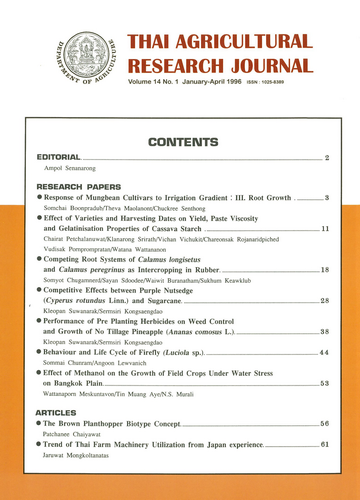Competing Root Systems of Calamus longisetus and Calamus peregrinus as Intercropping in Rubber
Keywords:
competing root systems, calamus spp.,, intercropping, rubberAbstract
To develop rattan as a supplementary crop in rubber plntation, an experiment was established in soulthern Thailand. in 1989, two species of rattan (C. longisetus and C. peregrinus) were grown between rows of 3-year rubber (KRS 156 clone with spacing 3x7 m). Six years after planting, root systems of the rattan species were investigated by soil-coring at 0.5, 1.0, 1.5, 2.0 and 2.5 m away from both sides of each rattan plant and 3 layers of soil depth (0-15 , 15-30, 30-45 cm). Soil samples were collected at each sampling point with 4 replications, and 4 plants of each species were used. Evaluation of feeder root distribution of both rattan species, it was found that the greatest feeder root proliferation was in the top soil (0-15 cm) and the proliferation decreased with depth. Feeder root density and distribution of C. longisetus were greater than those of C. peregrinus. Corresponding to the relative rooting densities between rattan and rubber; C. longisetus exhibited high relative rooting density between rattan and rubber; C. longisetus exhibited high relative rooting density through the soil profile of study zone, whereas the high relative rooting density of C. peregrinus was found 1.5 m away. It is sugested that C. longisetus compets more effectively, this leads to high competition with th erubber.
Downloads
Published
How to Cite
Issue
Section
License

This work is licensed under a Creative Commons Attribution-NonCommercial-NoDerivatives 4.0 International License.
Thai Agricultural Research Journal


